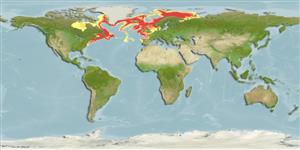Classification / Names
Common names from other countries
Main reference
Size / Weight / Age
Max length : 730 cm TL male/unsexed; (Ref. 247); max. published weight: 775.0 kg (Ref. 4699); max. reported age: 392 years (Ref. 110949)
Length at first maturity
Lm ?, range 244 - 427 cm
Environment
Marine; brackish; benthopelagic; depth range 0 - 2200 m (Ref. 247), usually 200 - 600 m (Ref. 35388)
Climate / Range
Deep-water; 1°C - 12°C (Ref. 247), preferred 6°C (Ref. 107945); 83°N - 35°N, 95°W - 61°E
Distribution
Short description
Dorsal
spines
(total): 0;
Dorsal
soft rays
(total): 0;
Anal
spines: 0;
Anal
soft rays: 0;
Vertebrae: 41 - 44. A gigantic, heavily-bodied dogfish shark with a moderately long, rounded snout and small, low dorsal fins; lower caudal lobe long; upper jaw with small single-cusped teeth and lower jaw with moderate-sized, bent-cusped, slicing teeth (Ref. 5578). Medium grey or brown in color, sometimes with transverse dark bands or small light spots (Ref. 5578).
IUCN Red List Status (Ref. 115185)
Threat to humans
Poisonous to eat (Ref. 4690)
Human uses
Fisheries: minor commercial; gamefish: yes
More information
ReferencesAquacultureAquaculture profileStrainsGeneticsAllele frequenciesHeritabilityDiseasesProcessingMass conversion
Tools
Special reports
Download XML
Internet sources
Estimates of some properties based on models
Phylogenetic diversity index
PD50 = 0.5313 many relatives (e.g. carps) 0.5 - 2.0 few relatives (e.g. lungfishes)
Trophic Level
4.2 ±0.6 se; Based on diet studies.
Resilience
Very Low, minimum population doubling time more than 14 years (Fec=10; assuming tm>10)
Vulnerability
Very high vulnerability (90 of 100)
Price category
